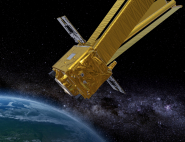T-SAGE Instrument
The T-SAGE (Twin-Space Accelerometer for Gravity Experiment) instrument is composed of two differential accelerometers, each consisting of a mechanical part and an electronic part.
The mechanical part is mainly composed of two concentric cylindrical proof masses with six degrees of freedom. The functioning principle for the two masses is similar: they are maintained in the centre of a silica cage by electrostatic forces (electrostatic levitation). The position and attitude variations of a proof mass, induced by a modification of the environment, are measured with capacitance detectors. Through control loops, these measurements generate voltages applied to electrodes on the silica cylinder and distributed around the proof masses which are converted into electrostatic forces that maintain its position and orientation. Measurement of the applied voltages indicates the acceleration of the proof mass.
![]()
To test the equivalence principle (i.e. the same free fall for two bodies of different composition in an identical gravity field), two differential accelerometers are used. One has proof masses made of different materials (platinum and titanium); the other, whose two proof masses are of the same material (platinum), serves as a measurement reference for the experiment.
![]() Watch the T-SAGE instrument being assembled
Watch the T-SAGE instrument being assembled
The challenge of the T-SAGE instrument developed by ONERA for the Microscope mission lies in the targeted levels of performance, requiring extreme accuracies and mechanical fits while withstanding the constraints of space missions, in particular during launch.
Some of the orders of magnitude involved:
- Total mass of the instrument: 50 kg
- Proof masses:
- inner mass in platinum = 0.5 kg
- outer mass in platinum = 1.4 kg
- outer mass in titanium = 0.3 kg
- Acceleration measurement resolution = 0.1 pico-g/Hz½ in the range [10-3Hz - 2x10-2 Hz]
- Payload harness: 7 wires with a diameter of 7µm and 25 mm long

